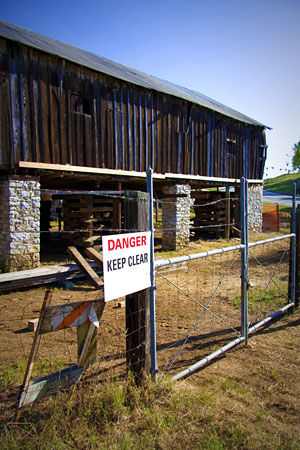The cooperage is getting a little help from its Friends.
The historic building near the base of campus--on the left as you pass the Cook House just past the main entrance--is undergoing temporary reinforcement to keep it standing as time takes its toll on the structure, according to Damon Adlao, project manager with Physical Planning and Construction.
The project, which will cost about $60,000, is being supported in part with private donations raised by the Friends of the Cowell Lime Works Historic District, including a $25,000 President's Emergency Grant from the S.H. Cowell Foundation, whose funds originally came in part from the lime works operated by Henry Cowell at the campus site. Friends volunteers also are working to restore a historic workers' cabin and other structures on the the site with assistance from the local and state Cabrillo Civic Clubs of California and donations from Big Creek Lumber Company.
"The problem with the cooperage is the existing foundations were made from old quarry rock from here on site, and the entire building is up on eight-foot-tall pillars," said Adlao, a UCSC alumnus (Porter, '94). "Those are starting to fail--they're close to 150 years old, and the entire building is starting to shift. It's something that's been getting worse and worse every year, and from everyone's calculations, it wasn't going to last very long. So we're doing an emergency triage, so to speak, to hold the building up."
The Cowell Lime Works District--an area of 30 acres near the base of campus that is on the National Register of Historic Places--includes four lime kilns, the cooperage (where barrels were made), the hay barn, cook house, lime worker cabins, Cardiff house, and many other historic structures.
In the 1850s and '60s, the area was the center of the largest lime manufacturing area in California. As a vital building material, lime played a key role in the development of California cities after the Gold Rush.
In addition to holding the building up, the temporary shoring of the cooperage will also make it safe for volunteers and campus staff to go inside it to assess its structural integrity as well as its contents.
"Once we make that assessment, we'll have an understanding of what's next," Adlao said.
The Friends group and Physical Planning and Construction hope to get funding to rehabilitate the entire cooperage site, said Adlao.
"Right now, we're just getting it safe and shoring it up so we don't lose it," Adlao said. "It's an iconic resource."
As an alumnus, working on the cooperage project has extra layer of meaning for Adlao.
"And people I've talked to, other alumni, agree it lends a certain character to UCSC--without it, there would be something lost," Adlao said. "It has almost as much power as the main sign as far as an entry sequence on the campus."
In other news, the Friends of the Cowell Lime Works Historic District recently received a certificate of appreciation from the Santa Cruz Historic Preservation Commission for contributing to the city's history through its grassroots organization dedicated to the study and rehabilitation of the Cowell Lime Works.
Related links:
- Friends of the Cowell Lime Works Historic District
- Inaugural Conference on Lime and Lime Kilns in California History, August 8-9, 2009




